A Comprehensive Review of Lithium-Ion Capacitor Technology: Theory, Development, Modeling, Thermal Management Systems, and Applications
Abstract
:1. Introduction
2. Various Types of Energy Storage Systems
2.1. Lithium-Ion Batteries (LiBs)
2.2. Electric Double-Layer Capacitors (EDLCs)
2.3. Lithium-Ion Capacitors (LiCs)
2.4. Construction of Lithium-Ion Capacitors
3. 1D Electrical, Thermal, and Lifetime Modeling
3.1. Electrical Modeling
3.2. Lifetime Modeling
3.3. Thermal Modeling
3.3.1. Heat Transfer Modeling of LiCs
3.3.2. Heat Generation Mechanism of LiCs
4. Application of LiCs
5. Conclusions
Author Contributions
Funding
Institutional Review Board Statement
Informed Consent Statement
Data Availability Statement
Acknowledgments
Conflicts of Interest
References
- Gandoman, F.H.; Jaguemont, J.; Goutam, S.; Gopalakrishnan, R.; Firouz, Y.; Kalogiannis, T.; Omar, N.; Van Mierlo, J. Concept of Reliability and Safety Assessment of Lithium-Ion Batteries in Electric Vehicles: Basics, Progress, and Challenges. Appl. Energy 2019, 251, 113343. [Google Scholar] [CrossRef]
- Mahmoudzadeh Andwari, A.; Pesiridis, A.; Rajoo, S.; Martinez-Botas, R.; Esfahanian, V. A Review of Battery Electric Vehicle Technology and Readiness Levels. Renew. Sustain. Energy Rev. 2017, 78, 414–430. [Google Scholar] [CrossRef]
- Van Mierlo, J.; Berecibar, M.; El Baghdadi, M.; De Cauwer, C.; Messagie, M.; Coosemans, T.; Jacobs, V.A.; Hegazy, O. Beyond the State of the Art of Electric Vehicles: A Fact-Based Paper of the Current and Prospective Electric Vehicle Technologies. World Electr. Veh. J. 2021, 12, 20. [Google Scholar] [CrossRef]
- De Hoog, J.; Jaguemont, J.; Abdel-Monem, M.; Van Den Bossche, P.; Van Mierlo, J.; Omar, N. Combining an Electrothermal and Impedance Aging Model to Investigate Thermal Degradation Caused by Fast Charging. Energies 2018, 11, 804. [Google Scholar] [CrossRef] [Green Version]
- Dubal, D.P.; Ayyad, O.; Ruiz, V.; Gómez-Romero, P. Hybrid Energy Storage: The Merging of Battery and Supercapacitor Chemistries. Chem. Soc. Rev. 2015, 44, 1777–1790. [Google Scholar] [CrossRef]
- Soltani, M.; Ronsmans, J.; Jaguemont, J.; Van Mierlo, J.; Van Den Bossche, P.; Omar, N. A Three-Dimensional Thermal Model for a Commercial Lithium-Ion Capacitor Battery Pack with Non-Uniform Temperature Distribution. In Proceedings of the 2019 IEEE International Conference on Industrial Technology, Melbourne, Australia, 13–15 February 2019; pp. 1126–1131. [Google Scholar] [CrossRef]
- Gao, L.; Dougal, R.A.; Liu, S. Active Power Sharing in Hybrid Battery/Capacitor Power Sources. In Proceedings of the Eighteenth Annual IEEE Applied Power Electronics Conference and Exposition, Miami Beach, FL, USA, 9–13 February 2003; 1, pp. 497–503. [Google Scholar] [CrossRef]
- Lahyani, A.; Sari, A.; Lahbib, I.; Venet, P. Optimal Hybridization and Amortized Cost Study of Battery/Supercapacitors System under Pulsed Loads. J. Energy Storage 2016, 6, 222–231. [Google Scholar] [CrossRef]
- Miller, J.R. Engineering Electrochemical Capacitor Applications. J. Power Sources 2016, 326, 726–735. [Google Scholar] [CrossRef]
- Zuo, W.; Li, R.; Zhou, C.; Li, Y.; Xia, J.; Liu, J. Battery-Supercapacitor Hybrid Devices: Recent Progress and Future Prospects. Adv. Sci. 2017, 4, 1–21. [Google Scholar] [CrossRef]
- Behi, H.; Karimi, D.; Jaguemont, J.; Berecibar, M.; Mierlo, J. Van Experimental Study on Cooling Performance of Flat Heat Pipe for Lithium-Ion Battery at Various Inclination Angels. Energy Perspect. 2020, 1, 77–92. [Google Scholar]
- Möller, S.; Karimi, D.; Vanegas, O.; El Baghdadi, M.; Kospach, A.; Lis, A.; Hegazy, O.; Abart, C.; Offenbach, Â.B.Â. Application Considerations for Double Sided Cooled Modules in Automotive Environment. In Proceedings of the CIPS 2020; 11th International Conference on Integrated Power Electronics Systems, Berlin, Germany, 24–26 March 2020; VDE: Berlin, Germany, 2020. [Google Scholar]
- Dunn, B.; Kamath, H.; Tarascon, J.M. Electrical Energy Storage for the Grid: A Battery of Choices. Science 2011, 334, 928–935. [Google Scholar] [CrossRef] [PubMed] [Green Version]
- Chen, Y.; Kang, Y.; Zhao, Y.; Wang, L.; Liu, J.; Li, Y.; Liang, Z.; He, X.; Li, X.; Tavajohi, N.; et al. A Review of Lithium-Ion Battery Safety Concerns: The Issues, Strategies, and Testing Standards. J. Energy Chem. 2021, 59, 83–99. [Google Scholar] [CrossRef]
- Liu, X.; Ren, D.; Hsu, H.; Feng, X.; Xu, G.L.; Zhuang, M.; Gao, H.; Lu, L.; Han, X.; Chu, Z.; et al. Thermal Runaway of Lithium-Ion Batteries without Internal Short Circuit. Joule 2018, 2, 2047–2064. [Google Scholar] [CrossRef] [Green Version]
- Lu, W.; Belharouak, I.; Liu, J.; Amine, K. Thermal Properties of Li4/3Ti5/3O4/LiMn2O4 Cell. J. Power Sources 2007, 174, 673–677. [Google Scholar] [CrossRef]
- Amine, K.; Belharouak, I.; Chen, Z.; Tran, T.; Yumoto, H.; Ota, N.; Myung, S.T.; Sun, Y.K. Nanostructured Anode Material for High-Power Battery System in Electric Vehicles. Adv. Mater. 2010, 22, 3052–3057. [Google Scholar] [CrossRef]
- Fernando, J. Electrical Double-Layer Capacitors. In Energy Storage Devices for Renewable Energy-Based Systems; Elsevier: Amsterdam, The Netherlands, 2021; pp. 199–237. ISBN 978-0-12-820778-9. [Google Scholar]
- Fleischmann, S.; Mitchell, J.B.; Wang, R.; Zhan, C.; Jiang, D.; Presser, V.; Augustyn, V. Pseudocapacitance: From Fundamental Understanding to High Power Energy Storage Materials. Chem. Rev. 2020, 120, 6738–6782. [Google Scholar] [CrossRef]
- Tarascon, J.M.; Armand, M. Issues and Challenges Facing Rechargeable Lithium Batteries. Nature 2001, 414, 359–367. [Google Scholar] [CrossRef]
- Zhang, J.; Liu, X.; Wang, J.; Shi, J.; Shi, Z. Different Types of Pre-Lithiated Hard Carbon as Negative Electrode Material for Lithium-Ion Capacitors. Electrochim. Acta 2016, 187, 134–142. [Google Scholar] [CrossRef]
- Zhang, L. High-Power Energy Storage: Ultracapacitors. In Modeling, Dynamics, and Control of Electrified Vehicles; Elsevier Inc.: Amsterdam, The Netherlands, 2018; pp. 39–75. ISBN 9780128131091. [Google Scholar]
- Wang, H.; Zhu, C.; Chao, D.; Yan, Q.; Fan, H.J. Nonaqueous Hybrid Lithium-Ion and Sodium-Ion Capacitors. Adv. Mater. 2017, 29, 1702093. [Google Scholar] [CrossRef]
- El Ghossein, N.; Sari, A.; Venet, P. Interpretation of the Particularities of Lithium-Ion Capacitors and Development of a Simple Circuit Model. In Proceedings of the 2016 IEEE Vehicle Power and Propulsion Conference (VPPC), Hangzhou, China, 17-20 October 2016. [Google Scholar] [CrossRef] [Green Version]
- Nursyafarinah, N.; Junipuspita, D.; Widayatno, W.; Wismogroho, A.S.; Amal, M.I.; Priyono, S.; Tahir, D.; Armynah, B. Low Temperature Preparation of Chicken Bone-Based Porous Carbon for Lithium Ion Capacitor (LIC) Cathode. J. Phys. Conf. Ser. 2019, 1191, 012019. [Google Scholar] [CrossRef]
- Soltani, M.; Beheshti, S.H. A Comprehensive Review of Lithium Ion Capacitor: Development, Modelling, Thermal Management and Applications. J. Energy Storage 2020, 34, 102019. [Google Scholar] [CrossRef]
- Ma, Y.; Chang, H.; Zhang, M.; Chen, Y. Graphene-Based Materials for Lithium-Ion Hybrid Supercapacitors. Adv. Mater. 2015, 27, 5296–5308. [Google Scholar] [CrossRef] [PubMed]
- Naoi, K.; Ishimoto, S.; Miyamoto, J.; Naoi, W. Second Generation ‘Nanohybrid Supercapacitor’: Evolution of Capacitive Energy Storage Devices. Energy Environ. Sci. 2012, 5, 9363–9373. [Google Scholar] [CrossRef]
- Zhang, L.; Yang, X.; Zhang, F.; Long, G.; Zhang, T.; Leng, K.; Zhang, Y.; Huang, Y.; Ma, Y.; Zhang, M.; et al. Controlling the Effective Surface Area and Pore Size Distribution of Sp2 Carbon Materials and Their Impact on the Capacitance Performance of These Materials. J. Am. Chem. Soc. 2013, 135, 5921–5929. [Google Scholar] [CrossRef]
- Lamb, J.J.; Burheim, O.S. Lithium-Ion Capacitors: A Review of Design and Active Materials. Energies 2021, 14, 1–27. [Google Scholar] [CrossRef]
- Soltani, M.; Ronsmans, J.; Van Mierlo, J. Cycle Life and Calendar Life Model for Lithium-Ion Capacitor Technology in a Wide Temperature Range. J. Energy Storage 2020, 31, 101659. [Google Scholar] [CrossRef]
- Bolufawi, O.; Shellikeri, A.; Zheng, J.P. Lithium-Ion Capacitor Safety Testing for Commercial Application. Batteries 2019, 5, 74. [Google Scholar] [CrossRef] [Green Version]
- Abdel-Monem, M.; Hegazy, O.; Omar, N.; Trad, K.; De Breucker, S.; Van Den Bossche, P.; Van Mierlo, J. Design and Analysis of Generic Energy Management Strategy for Controlling Second-Life Battery Systems in Stationary Applications. Energies 2016, 9, 889. [Google Scholar] [CrossRef] [Green Version]
- Berckmans, G.; Jaguemont, J.; Soltani, M.; Samba, A.; Boninsegna, M.; Omar, N.; Hegazy, O.; Van Mierlo, J.; Ronsmans, J. Lithium-Ion Capacitor—Optimization of Thermal Management From Cell To Module Level. In Proceedings of the 2016 IEEE Vehicle Power and Propulsion Conference (VPPC), Hangzhou, China, 17–20 October 2016; 2016; pp. 1–6. [Google Scholar]
- Hosen, M.S.; Karimi, D.; Kalogiannis, T.; Pirooz, A.; Jaguemont, J.; Berecibar, M.; Van Mierlo, J. Electro-Aging Model Development of Nickel-Manganese-Cobalt Lithium-Ion Technology Validated with Light and Heavy-Duty Real-Life Profiles. J. Energy Storage 2020, 28, 101265. [Google Scholar] [CrossRef]
- Hosen, M.S.; Kalogiannis, T.; Youssef, R.; Karimi, D.; Behi, H.; Jin, L.; Van Mierlo, J.; Berecibar, M. Twin-Model Framework Development for a Comprehensive Battery Lifetime Prediction Validated with a Realistic Driving Profile. Energy Sci. Eng. 2021, 9, 2191–2201. [Google Scholar] [CrossRef]
- Khaleghi, S.; Hosen, M.S.; Karimi, D.; Behi, H.; Beheshti, S.H.; Van Mierlo, J.; Berecibar, M. Developing an Online Data-Driven Approach for Prognostics and Health Management of Lithium-Ion Batteries. Appl. Energy 2022, 308, 118348. [Google Scholar] [CrossRef]
- Zhang, L.; Hu, X.; Wang, Z.; Sun, F.; Dorrell, D.G. A Review of Supercapacitor Modeling, Estimation, and Applications: A Control/Management Perspective. Renew. Sustain. Energy Rev. 2018, 81, 1868–1878. [Google Scholar] [CrossRef]
- Bahiraei, F.; Fartaj, A.; Nazri, G.A. Electrochemical-Thermal Modeling to Evaluate Active Thermal Management of a Lithium-Ion Battery Module. Electrochim. Acta 2017, 254, 59–71. [Google Scholar] [CrossRef]
- Wang, Y.; Li, M.; Chen, Z. Experimental Study of Fractional-Order Models for Lithium-Ion Battery and Ultra-Capacitor: Modeling, System Identification, and Validation. Appl. Energy 2020, 278, 115736. [Google Scholar] [CrossRef]
- He, H.; Xiong, R.; Fan, J. Evaluation of Lithium-Ion Battery Equivalent Circuit Models for State of Charge Estimation by an Experimental Approach. Energies 2011, 4, 582–598. [Google Scholar] [CrossRef]
- Karimi, D.; Khaleghi, S.; Behi, H.; Beheshti, H.; Hosen, M.S.; Akbarzadeh, M.; Van Mierlo, J.; Berecibar, M. Lithium-Ion Capacitor Lifetime Extension through an Optimal Thermal Management System for Smart Grid Applications. Energies 2021, 14, 2907. [Google Scholar] [CrossRef]
- Al-Zareer, M.; Dincer, I.; Rosen, M.A. A Novel Phase Change Based Cooling System for Prismatic Lithium Ion Batteries. Int. J. Refrig. 2018, 86, 203–217. [Google Scholar] [CrossRef]
- Hu, X.; Li, S.; Peng, H. A Comparative Study of Equivalent Circuit Models for Li-Ion Batteries. J. Power Sources 2012, 198, 359–367. [Google Scholar] [CrossRef]
- Ganesan, N.; Basu, S.; Hariharan, K.S.; Kolake, S.M.; Song, T.; Yeo, T.; Sohn, D.K.; Doo, S. Physics Based Modeling of a Series Parallel Battery Pack for Asymmetry Analysis, Predictive Control and Life Extension. J. Power Sources 2016, 322, 57–67. [Google Scholar] [CrossRef]
- Tippmann, S.; Walper, D.; Balboa, L.; Spier, B.; Bessler, W.G. Low-Temperature Charging of Lithium-Ion Cells Part I: Electrochemical Modeling and Experimental Investigation of Degradation Behavior. J. Power Sources 2014, 252, 305–316. [Google Scholar] [CrossRef]
- Schmidt, A.P.; Bitzer, M.; Imre, Á.W.; Guzzella, L. Lumped Parameter Modeling of Electrochemical and Thermal Dynamics in Lithium-Ion Batteries. IFAC Proc. Vol. 2010, 43, 198–203. [Google Scholar] [CrossRef]
- Mele, I.; Pačnik, I.; Zelič, K.; Moškon, J.; Katrašnik, T. Advanced Porous Electrode Modelling Framework Based on More Consistent Virtual Representation of the Electrode Topology. J. Electrochem. Soc. 2020, 167, 060531. [Google Scholar] [CrossRef]
- Seaman, A.; Dao, T.S.; McPhee, J. A Survey of Mathematics-Based Equivalent-Circuit and Electrochemical Battery Models for Hybrid and Electric Vehicle Simulation. J. Power Sources 2014, 256, 410–423. [Google Scholar] [CrossRef] [Green Version]
- Tran, M.-K.; DaCosta, A.; Mevawalla, A.; Panchal, S.; Fowler, M. Comparative Study of Equivalent Circuit Models Performance in Four Common Lithium-Ion Batteries: LFP, NMC, LMO, NCA. Batteries 2021, 7, 51. [Google Scholar] [CrossRef]
- Balasingam, B.; Pattipati, K.R. On the Identification of Electrical Equivalent Circuit Models Based on Noisy Measurements. IEEE Trans. Instrum. Meas. 2021, 70, 2507316. [Google Scholar] [CrossRef]
- Naseri, F.; Schaltz, E.; Stroe, D.I.; Gismero, A.; Farjah, E. An Enhanced Equivalent Circuit Model with Real-Time Parameter Identification for Battery State-of-Charge Estimation. IEEE Trans. Ind. Electron. 2021, 69, 3743–3751. [Google Scholar] [CrossRef]
- Nakajo, K.; Aoki, S.; Yatsuda, T.; Takahashi, S.; Motegi, K.; Kobayashi, Y.; Shiraishi, Y.; Nakajo, K.; Aoki, S.; Yatsuda, T.; et al. Modeling of a Lithium-Ion Capacitor and Its Charging and Discharging Circuit in a Model-Based Design. Circuits Syst. 2016, 7, 11–22. [Google Scholar] [CrossRef] [Green Version]
- Omar, N.; Daowd, M.; Hegazy, O.; Al Sakka, M.; Coosemans, T.; Van Den Bossche, P.; Van Mierlo, J. Assessment of Lithium-Ion Capacitor for Using in Battery Electric Vehicle and Hybrid Electric Vehicle Applications. Electrochim. Acta 2012, 86, 305–315. [Google Scholar] [CrossRef]
- Hamidi, S.A.; Manla, E.; Nasiri, A. Li-Ion Batteries and Li-Ion Ultracapacitors: Characteristics, Modeling and Grid Applications. In Proceedings of the 2015 IEEE Energy Conversion Congress and Exposition, ECCE 2015, Montreal, Canada, 20–24 September 2015; Institute of Electrical and Electronics Engineers Inc.: Piscataway, NJ, USA, 2015; pp. 4973–4979. [Google Scholar]
- Manla, E.; Mandic, G.; Nasiri, A. Development of an Electrical Model for Lithium-Ion Ultracapacitors. IEEE J. Emerg. Sel. Top. Power Electron. 2015, 3, 395–404. [Google Scholar] [CrossRef]
- Xiong, R.; Wang, S.; Yu, C.; Xia, L. An Estimation Method for Lithium-Ion Battery SOC of Special Robots Based on Thevenin Model and Improved Extended Kalman. Energy Storage Sci. Technol. 2021, 10, 695. [Google Scholar] [CrossRef]
- Fleurbaey, K.; Ronsmans, J.; De Hoog, J.; Nikolian, A.; Timmermans, J.M.; Omar, N.; Van Den Bossche, P.; Van Mierlo, J. Lithium-Ion Capacitor—Electrical and Thermal Characterization of Advanced Rechargeable Energy Storage Component. Eur. Electr. Veh. Congr. 2014, 1–11. [Google Scholar]
- Firouz, Y.; Omar, N.; Van Den Bossche, P.; Van Mierlo, J. Electro-Thermal Modeling of New Prismatic Lithium-Ion Capacitors. In Proceedings of the 2014 IEEE Vehicle Power and Propulsion Conference (VPPC), Coimbra, Portugal, 27–30 October 2014; 2015. [Google Scholar] [CrossRef]
- Bruch, M.; Millet, L.; Kowal, J.; Vetter, M. Novel Method for the Parameterization of a Reliable Equivalent Circuit Model for the Precise Simulation of a Battery Cell’s Electric Behavior. J. Power Sources 2021, 490, 229513. [Google Scholar] [CrossRef]
- Zhang, J.; Wang, P.; Liu, Y.; Cheng, Z. Variable-Order Equivalent Circuit Modeling and State of Charge Estimation of Lithium-Ion Battery Based on Electrochemical Impedance Spectroscopy. Energies 2021, 14, 769. [Google Scholar] [CrossRef]
- Varini, M.; Campana, P.E.; Lindbergh, G. A Semi-Empirical, Electrochemistry-Based Model for Li-Ion Battery Performance Prediction over Lifetime. J. Energy Storage 2019, 25, 100819. [Google Scholar] [CrossRef]
- Ramsey, D.; German, R.; Bouscayrol, A.; Boulon, L. Comparison of Equivalent Circuit Battery Models for Energetic Studies on Electric Vehicles. In Proceedings of the 2020 IEEE Vehicle Power and Propulsion Conference (VPPC), Gijon, Spain, 18 November–16 December 2020. [Google Scholar] [CrossRef]
- ER-RAKIBI, M. Lithium-Ion Battery Modeling Using Equivalent Circuit Model. Int. J. Eng. Appl. Phys. 2021, 1, 48–60. [Google Scholar]
- Ahmed, R.; Rahimifard, S.; Habibi, S. Offline Parameter Identification and SOC Estimation for New and Aged Electric Vehicles Batteries. In Proceedings of the 2019 IEEE Transportation Electrification Conference and Expo (ITEC), Detroit, MI, USA, 19–21 June 2019. [Google Scholar] [CrossRef]
- Lukic, M.; Giangrande, P.; Klumpner, C.; Galea, M. Novel Parameter Identification Method for Lithium-Ion Batteries Based on Curve Fitting. In Proceedings of the 2020 IEEE Vehicle Power and Propulsion Conference (VPPC), Gijon, Spain, 18 November–16 December 2020. [Google Scholar] [CrossRef]
- Feng, Y.-F.; Shen, J.-N.; Ma, Z.-F.; He, Y.-J. Equivalent Circuit Modeling of Sodium-Ion Batteries. J. Energy Storage 2021, 43, 103233. [Google Scholar] [CrossRef]
- Ruan, H.; Sun, B.; Jiang, J.; Zhang, W.; He, X.; Su, X.; Bian, J.; Gao, W. A Modified-Electrochemical Impedance Spectroscopy-Based Multi-Time-Scale Fractional-Order Model for Lithium-Ion Batteries. Electrochim. Acta 2021, 394, 139066. [Google Scholar] [CrossRef]
- Jiang, C.; Wang, S.; Wu, B.; Fernandez, C.; Xiong, X.; Coffie-Ken, J. A State-of-Charge Estimation Method of the Power Lithium-Ion Battery in Complex Conditions Based on Adaptive Square Root Extended Kalman Filter. Energy 2021, 219, 119603. [Google Scholar] [CrossRef]
- Movassagh, K.; Raihan, A.; Balasingam, B.; Pattipati, K. A Critical Look at Coulomb Counting Approach for State of Charge Estimation in Batteries. Energies 2021, 14, 4074. [Google Scholar] [CrossRef]
- Uno, M.; Kukita, A. Cycle Life Evaluation Based on Accelerated Aging Testing for Lithium-Ion Capacitors as Alternative to Rechargeable Batteries. IEEE Trans. Ind. Electron. 2016, 63, 1607–1617. [Google Scholar] [CrossRef]
- Zhang, L.; Wang, Z.; Sun, F.; Dorrell, D.G. Online Parameter Identification of Ultracapacitor Models Using the Extended Kalman Filter. Energies 2014, 7, 3204–3217. [Google Scholar] [CrossRef]
- Li, X.; Huang, Z.; Tian, J.; Tian, Y. State-of-Charge Estimation Tolerant of Battery Aging Based on a Physics-Based Model and an Adaptive Cubature Kalman Filter. Energy 2021, 220, 119767. [Google Scholar] [CrossRef]
- Ling, L.; Wei, Y. State-of-Charge and State-of-Health Estimation for Lithium-Ion Batteries Based on Dual Fractional-Order Extended Kalman Filter and Online Parameter Identification. IEEE Access 2021, 9, 47588–47602. [Google Scholar] [CrossRef]
- Wu, M.; Qin, L.; Wu, G.; Huang, Y.; Shi, C. State of Charge Estimation of Power Lithium-Ion Battery Based on a Variable Forgetting Factor Adaptive Kalman Filter. J. Energy Storage 2021, 41, 102841. [Google Scholar] [CrossRef]
- Nian, P.; Shuzhi, Z.; Xiongwen, Z. Co-Estimation for Capacity and State of Charge for Lithium-Ion Batteries Using Improved Adaptive Extended Kalman Filter. J. Energy Storage 2021, 40, 102559. [Google Scholar] [CrossRef]
- Zhou, J.; Liu, D.; Peng, Y.; Peng, X. An Optimized Relevance Vector Machine with Incremental Learning Strategy for Lithium-Ion Battery Remaining Useful Life Estimation. In Proceedings of the 2013 IEEE International Instrumentation and Measurement Technology Conference (I2MTC), Minneapolis, MN, USA, 6–9 May 2013. [Google Scholar] [CrossRef]
- Alvarez Anton, J.C.; Garcia Nieto, P.J.; Blanco Viejo, C.; Vilan Vilan, J.A. Support Vector Machines Used to Estimate the Battery State of Charge. IEEE Trans. Power Electron. 2013, 28, 5919–5926. [Google Scholar] [CrossRef]
- Khaleghi, S.; Karimi, D.; Beheshti, S.H.; Hosen, S.; Behi, H.; Berecibar, M.; Mierlo, J. Van Online Health Diagnosis of Lithium-Ion Batteries Based on Nonlinear Autoregressive Neural Network. Appl. Energy 2021, 282, 116159. [Google Scholar] [CrossRef]
- Liu, F.; Ma, J.; Su, W. Unscented Particle Filter for SOC Estimation Algorithm Based on a Dynamic Parameter Identification. Math. Probl. Eng. 2019, 2019, 7452079. [Google Scholar] [CrossRef] [Green Version]
- Sun, B.; Liu, J.; Ruan, H.; Zhang, W.; Li, H.; Wang, J. Study on Fractional Order Modeling and Equivalent Stress of AC–DC Superposition Condition for Lithium-Ion Batteries. Lect. Notes Electr. Eng. 2021, 743, 115–127. [Google Scholar] [CrossRef]
- Lambert, S.M.; Pickert, V.; Holden, J.; He, X.; Li, W. Comparison of Supercapacitor and Lithium-Ion Capacitor Technologies for Power Electronics Applications. In Proceedings of the 5th IET International Conference on Power Electronics, Machines and Drives, Brighton, UK, 19–21 April 2010; 2010. [Google Scholar] [CrossRef]
- Gualous, H.; Alcicek, G.; Diab, Y.; Hammar, A.; Venet, P.; Akiyama, M.; Marumo, C. Lithium Ion Capacitor Characterization and Modelling. In Proceedings of the 3rd European Symposium on Supercapacitors and Applications, Rome, Italy, 6–7 November 2008. [Google Scholar]
- Barcellona, S.; Ciccarelli, F.; Iannuzzi, D.; Piegari, L. Modeling and Parameter Identification of Lithium-Ion Capacitor Modules. IEEE Trans. Sustain. Energy 2014, 5, 785–794. [Google Scholar] [CrossRef]
- Barcellona, S.; Piegari, L. A Lithium-Ion Capacitor Model Working on a Wide Temperature Range. J. Power Sources 2017, 342, 241–251. [Google Scholar] [CrossRef]
- Firouz, Y.; Omar, N.; Timmermans, J.M.; Van den Bossche, P.; Van Mierlo, J. Lithium-Ion Capacitor-Characterization and Development of New Electrical Model. Energy 2015, 83, 597–613. [Google Scholar] [CrossRef]
- Liu, S.; Wang, J.; Liu, H.; Liu, Q.; Tang, J.; Li, Z. Battery Degradation Model and Multiple-Indicators Based Lifetime Estimator for Energy Storage System Design and Operation: Experimental Analyses of Cycling-Induced Aging. Electrochim. Acta 2021, 384, 138294. [Google Scholar] [CrossRef]
- Vanem, E.; Salucci, C.B.; Bakdi, A.; Alnes, Ø.Å. sheim Data-Driven State of Health Modelling—A Review of State of the Art and Reflections on Applications for Maritime Battery Systems. J. Energy Storage 2021, 43, 103158. [Google Scholar] [CrossRef]
- Lucu, M.; Gandiaga, I.; Camblong, H. Review Article A Critical Review on Self-Adaptive Li-Ion Battery Ageing Models. J. Power Sources 2018, 401, 85–101. [Google Scholar] [CrossRef]
- Wang, S.; Jin, S.; Bai, D.; Fan, Y.; Shi, H.; Fernandez, C. A Critical Review of Improved Deep Learning Methods for the Remaining Useful Life Prediction of Lithium-Ion Batteries. Energy Rep. 2021, 7, 5562–5574. [Google Scholar] [CrossRef]
- Zhang, Y.; Liu, Y.; Wang, J.; Zhang, T. State-of-Health Estimation for Lithium-Ion Batteries by Combining Model-Based Incremental Capacity Analysis with Support Vector Regression. Energy 2022, 239, 121986. [Google Scholar] [CrossRef]
- Wang, Z.; Song, C.; Yuan, C.; Li, X. A Flexible Method for State-of-Health Estimation of Lithium Battery Energy Storage System. Energy Rep. 2021, 7, 6375–6383. [Google Scholar] [CrossRef]
- Cao, W.J.; Shih, J.; Zheng, J.P.; Doung, T. Development and Characterization of Li-Ion Capacitor Pouch Cells. J. Power Sources 2014, 257, 388–393. [Google Scholar] [CrossRef]
- Sun, X.; Zhang, X.; Liu, W.; Wang, K.; Li, C.; Li, Z.; Ma, Y. Electrochemical Performances and Capacity Fading Behaviors of Activated Carbon/Hard Carbon Lithium Ion Capacitor. Electrochim. Acta 2017, 235, 158–166. [Google Scholar] [CrossRef]
- Chigada, P.I.; Wale, O.; Hancox, C.; Vandaele, K.; Breeze, B.; Mottram, A.; Roberts, A.J. Comparative Life Cycle Assessment of Lithium-Ion Capacitors Production from Primary Ore and Recycled Minerals Using Lca to Balance Environmental, Economic and Social Performance in Early Phase Research and Development. Johnson Matthey Technol. Rev. 2021, 65, 469–479. [Google Scholar] [CrossRef]
- El Ghossein, N.; Sari, A.; Venet, P. Effects of the Hybrid Composition of Commercial Lithium-Ion Capacitors on Their Floating Aging. IEEE Trans. Power Electron. 2019, 34, 2292–2299. [Google Scholar] [CrossRef]
- Omar, N.; Gualous, H.; Salminen, J.; Mulder, G.; Samba, A.; Firouz, Y.; Monem, M.A.; Van den Bossche, P.; Van Mierlo, J. Electrical Double-Layer Capacitors: Evaluation of Ageing Phenomena during Cycle Life Testing. J. Appl. Electrochem. 2014, 44, 509–522. [Google Scholar] [CrossRef]
- Fell, C.R.; Sun, L.; Hallac, P.B.; Metz, B.; Sisk, B. Investigation of the Gas Generation in Lithium Titanate Anode Based Lithium Ion Batteries. J. Electrochem. Soc. 2015, 162, A1916–A1920. [Google Scholar] [CrossRef]
- Huang, F.; Ma, J.; Xia, H.; Huang, Y.; Zhao, L.; Su, S.; Kang, F.; He, Y.B. Capacity Loss Mechanism of the Li4Ti5O12 Microsphere Anode of Lithium-Ion Batteries at High Temperature and Rate Cycling Conditions. ACS Appl. Mater. Interfaces 2019, 11, 37357–37364. [Google Scholar] [CrossRef]
- Yang, Z.; Huang, Q.; Li, S.; Mao, J. High-Temperature Effect on Electrochemical Performance of Li4Ti5O12 Based Anode Material for Li-Ion Batteries. J. Alloys Compd. 2018, 753, 192–202. [Google Scholar] [CrossRef]
- Handel, P.; Fauler, G.; Kapper, K.; Schmuck, M.; Stangl, C.; Fischer, R.; Uhlig, F.; Koller, S. Thermal Aging of Electrolytes Used in Lithium-Ion Batteries - An Investigation of the Impact of Protic Impurities and Different Housing Materials. J. Power Sources 2014, 267, 255–259. [Google Scholar] [CrossRef]
- Smart, M.C.; Ratnakumar, B.V.; Whitacre, J.F.; Whitcanack, L.D.; Chin, K.B.; Rodriguez, M.D.; Zhao, D.; Greenbaum, S.G.; Surampudi, S. Effect of Electrolyte Type upon the High-Temperature Resilience of Lithium-Ion Cells. J. Electrochem. Soc. 2005, 152, A1096. [Google Scholar] [CrossRef]
- El Ghossein, N.; Sari, A.; Venet, P.; Genies, S.; Azaïs, P. Post-Mortem Analysis of Lithium-Ion Capacitors after Accelerated Aging Tests. J. Energy Storage 2021, 33, 102039. [Google Scholar] [CrossRef]
- Behi, H.; Karimi, D.; Kalogiannis, T.; He, J.; Patil, M.S.; Muller, J.-D.; Haider, A.; Van Mierlo, J.; Berecibar, M. Advanced Hybrid Thermal Management System for LTO Battery Module Under Fast Charging. Case Stud. Therm. Eng. 2022, 33, 101938. [Google Scholar] [CrossRef]
- Akbarzadeh, M.; Kalogiannis, T.; Jaguemont, J.; Jin, L.; Behi, H.; Karimi, D.; Beheshti, H.; Van Mierlo, J.; Berecibar, M. A Comparative Study between Air Cooling and Liquid Cooling Thermal Management Systems for a High-Energy Lithium-Ion Battery Module. Appl. Therm. Eng. 2021, 198, 117503. [Google Scholar] [CrossRef]
- Behi, H.; Behi, M.; Karimi, D.; Jaguemont, J.; Ghanbarpour, M.; Behnia, M.; Berecibar, M.; Van Mierlo, J. Heat Pipe Air-Cooled Thermal Management System for Lithium-Ion Batteries: High Power Applications. Appl. Therm. Eng. 2020, 183, 116240. [Google Scholar] [CrossRef]
- Gualous, H.; Gallay, R.; Alcicek, G.; Tala-Ighil, B.; Oukaour, A.; Boudart, B.; Makany, P. Supercapacitor Ageing at Constant Temperature and Constant Voltage and Thermal Shock. Microelectron. Reliab. 2010, 50, 1783–1788. [Google Scholar] [CrossRef]
- Torregrossa, D.; Paolone, M. Modelling of Current and Temperature Effects on Supercapacitors Ageing. Part II: State-of-Health Assessment. J. Energy Storage 2016, 5, 95–101. [Google Scholar] [CrossRef]
- Torregrossa, D.; Paolone, M. Modelling of Current and Temperature Effects on Supercapacitors Ageing. Part I: Review of Driving Phenomenology. J. Energy Storage 2016, 5, 85–94. [Google Scholar] [CrossRef]
- Ayadi, M.; Briat, O.; Lallemand, R.; Eddahech, A.; Coquery, G.; Vinassa, J.-M.; German, R. Description of Supercapacitor Performance Degradation Rate during Thermal Cycling under Constant Voltage Ageing Test. Microelectron. Reliab. 2014, 54, 1944–1948. [Google Scholar] [CrossRef]
- Ayadi, M.; Briat, O.; Lallemand, R.; Coquery, G.; Vinassa, J.M. Influence of Thermal Cycling on Supercapacitor Performance Fading during Ageing Test at Constant Voltage. IEEE Int. Symp. Ind. Electron. 2014, 1823–1828. [Google Scholar] [CrossRef]
- Omar, N.; Ronsmans, J.; Firozu, Y.; Monem, M.A.; Samba, A.; Gualous, H.; Hegazy, O.; Smekens, J.; Coosemans, T.; Van den Bossche, P.; et al. Lithium-Ion Capacitor - Advanced Technology for Rechargeable Energy Storage Systems. World Electr. Veh. J. 2013, 6, 484–494. [Google Scholar] [CrossRef] [Green Version]
- Behi, H.; Karimi, D.; Gandoman, F.H.; Akbarzadeh, M.; Khaleghi, S.; Kalogiannis, T.; Hosen, M.S.; Jaguemont, J.; Van Mierlo, J.; Berecibar, M. PCM Assisted Heat Pipe Cooling System for the Thermal Management of an LTO Cell for High-Current Profiles. Case Stud. Therm. Eng. 2021, 25, 100920. [Google Scholar] [CrossRef]
- Behi, H.; Behi, M.; Ghanbarpour, A.; Karimi, D.; Azad, A.; Ghanbarpour, M.; Behnia, M. Enhancement of the Thermal Energy Storage Using Heat-Pipe-Assisted Phase Change Material. Energies 2021, 14, 6176. [Google Scholar] [CrossRef]
- Behi, H.; Karimi, D.; Youssef, R.; Suresh Patil, M.; Van Mierlo, J.; Berecibar, M. Comprehensive Passive Thermal Management Systems for Electric Vehicles. Energies 2021, 14, 3881. [Google Scholar] [CrossRef]
- Behi, H.; Karimi, D.; Jaguemont, J.; Gandoman, F.H.; Khaleghi, S.; Van Mierlo, J.; Berecibar, M. Aluminum Heat Sink Assisted Air-Cooling Thermal Management System for High Current Applications in Electric Vehicles. In Proceedings of the 2020 AEIT International Conference of Electrical and Electronic Technologies for Automotive, AEIT AUTOMOTIVE 2020, Torino, Italy, 18–20 November 2020; Institute of Electrical and Electronics Engineers Inc.: Piscataway, NJ, USA, 2020. [Google Scholar]
- Behi, H.; Karimi, D.; Jaguemont, J.; Gandoman, F.H.; Kalogiannis, T.; Berecibar, M.; Van Mierlo, J. Novel Thermal Management Methods to Improve the Performance of the Li-Ion Batteries in High Discharge Current Applications. Energy 2021, 224, 120165. [Google Scholar] [CrossRef]
- Karimi, D.; Behi, H.; Jaguemont, J.; El Baghdadi, M.; Van Mierlo, J.; Hegazy, O. Thermal Concept Design of MOSFET Power Modules in Inverter Subsystems for Electric Vehicles. In Proceedings of the 2019 9th International Conference on Power and Energy Systems, ICPES 2019, Perth, Australia, 10–12 December 2019. [Google Scholar]
- Zhang, X.; Klein, R.; Subbaraman, A.; Chumakov, S.; Li, X.; Christensen, J.; Linder, C.; Kim, S.U. Evaluation of Convective Heat Transfer Coefficient and Specific Heat Capacity of a Lithium-Ion Battery Using Infrared Camera and Lumped Capacitance Method. J. Power Sources 2019, 412, 552–558. [Google Scholar] [CrossRef]
- Wang, Q.; Huang, P.; Ping, P.; Du, Y.; Li, K.; Sun, J. Combustion Behavior of Lithium Iron Phosphate Battery Induced by External Heat Radiation. J. Loss Prev. Process Ind. 2017, 49, 961–969. [Google Scholar] [CrossRef]
- Bernardi, D. A General Energy Balance for Battery Systems. J. Electrochem. Soc. 1985, 132, 5. [Google Scholar] [CrossRef] [Green Version]
- Pals, C.R.; Newman, J. Thermal Modeling of the Lithium/Polymer Battery: II. Temperature Profiles in a Cell Stack. J. Electrochem. Soc. 1995, 142, 3282–3288. [Google Scholar] [CrossRef]
- Berckmans, G.; Brussel, V.U.; Ronsmans, J. Lithium-Ion Capacitor-Analysis of Thermal Behaviour and Development of 3D Thermal Model. Energies 2016, 14, 1–16. [Google Scholar]
- Soltani, M.; Berckmans, G.; Jaguemont, J.; Ronsmans, J.; Kakihara, S.; Hegazy, O.; Van Mierlo, J.; Omar, N. Three Dimensional Thermal Model Development and Validation for Lithium-Ion Capacitor Module Including Air-Cooling System. Appl. Therm. Eng. 2019, 153, 264–274. [Google Scholar] [CrossRef]
- Wei, L.; Wu, M.; Yan, M.; Liu, S.; Cao, Q.; Wang, H. A Review on Electrothermal Modeling of Supercapacitors for Energy Storage Applications. IEEE J. Emerg. Sel. Top. Power Electron. 2019, 7, 1677–1690. [Google Scholar] [CrossRef]
- Jaguemont, J.; Karimi, D.; Van Mierlo, J. Investigation of a Passive Thermal Management System for Lithium-Ion Capacitors. IEEE Trans. Veh. Technol. 2019, 68, 10518–10524. [Google Scholar] [CrossRef]
- Karimi, D.; Behi, H.; Jaguemont, J.; Sokkeh, M.A.; Kalogiannis, T.; Hosen, M.S.; Berecibar, M.; Van Mierlo, J. Thermal Performance Enhancement of Phase Change Material Using Aluminum-Mesh Grid Foil for Lithium-Capacitor Modules. J. Energy Storage 2020, 30, 101508. [Google Scholar] [CrossRef]
- Karimi, D.; Behi, H.; Hosen, M.S.; Jaguemont, J.; Berecibar, M.; Van Mierlo, J. A Compact and Optimized Liquid-Cooled Thermal Management System for High Power Lithium-Ion Capacitors. Appl. Therm. Eng. 2021, 185, 116449. [Google Scholar] [CrossRef]
- Karimi, D.; Jaguemont, J.; Behi, H.; Berecibar, M.; Van Den Bossche, P.; Van Mierlo, J. Passive Cooling Based Battery Thermal Management Using Phase Change Materials for Electric Vehicles. In Proceedings of the EVS33 International Electric Vehicle Symposium, Portland, OR, USA, 14–17 June 2020; pp. 1–12. [Google Scholar]
- Karimi, D.; Behi, H.; Jaguemont, J.; Berecibar, M.; Van Mierlo, J. Optimized Air-Cooling Thermal Management System for High Power Lithium-Ion Capacitors. Energy Perspect. 2020, 1, 93–105. [Google Scholar]
- Karimi, D.; Behi, H.; Jaguemont, J.; Berecibar, M.; Van Mierlo, J. Investigation of Extruded Heat Sink Assisted Air Cooling System for Lithium-Ion Capacitor Batteries. In Proceedings of the International Conference on Renewable Energy Systems and Environmental Engineering, Brussels, Belgium, 18 July–20 September 2020; Global Publisher: Brussels, Belgium, 2020; pp. 1–6. [Google Scholar]
- Karimi, D.; Hosen, M.S.; Behi, H.; Khaleghi, S.; Akbarzadeh, M.; Van Mierlo, J.; Berecibar, M. A Hybrid Thermal Management System for High Power Lithium-Ion Capacitors Combining Heat Pipe with Phase Change Materials. Heliyon 2021, 7, e07773. [Google Scholar] [CrossRef]
- Karimi, D.; Behi, H.; Akbarzadeh, M.; Van Mierlo, J.; Berecibar, M. Holistic 1D Electro-Thermal Model Coupled to 3D Thermal Model for Hybrid Passive Cooling System Analysis in Electric Vehicles. Energies 2021, 14, 5924. [Google Scholar] [CrossRef]
- Karimi, D.; Behi, H.; Akbarzadeh, M.; Van Mierlo, J.; Berecibar, M. A Novel Air-Cooled Thermal Management Approach towards High-Power Lithium-Ion Capacitor Module for Electric Vehicles. Energies 2021, 14, 7150. [Google Scholar] [CrossRef]
- Karimi, D.; Behi, H.; Akbarzadeh, M.; Khaleghi, S.; Van Mierlo, J.; Berecibar, M. Optimization of 1D/3D Electro-Thermal Model for Liquid-Cooled Lithium-Ion Capacitor Module in High Power Applications. Electricity 2021, 2, 503–523. [Google Scholar] [CrossRef]
- Karimi, D. Modular Methodology for Developing Comprehensive Active and Passive Thermal Management Systems for Electric Vehicle; Vrije Universiteit Brussel: Brussels, Belgium, 2022. [Google Scholar]
- Karimi, D.; Behi, H.; Jaguemont, J.; Berecibar, M.; Van Mierlo, J. A Refrigerant-Based Thermal Management System for a Fast Charging Process for Lithium-Ion Batteries. In Proceedings of the International Conference on Renewable Energy Systems and Environmental Engineering, Brussels, Belgium, 18 July–20 September 2020; Global Publisher: Brussels, Belgium, 2020; pp. 1–6. [Google Scholar]
- Akbarzadeh, M.; Jaguemont, J.; Kalogiannis, T.; Karimi, D.; He, J.; Jin, L.; Xie, P.; Van Mierlo, J.; Berecibar, M. A Novel Liquid Cooling Plate Concept for Thermal Management of Lithium-Ion Batteries in Electric Vehicles. Energy Convers. Manag. 2021, 231, 113862. [Google Scholar] [CrossRef]
- Behi, H.; Karimi, D.; Behi, M.; Jaguemont, J.; Ghanbarpour, M.; Behnia, M.; Berecibar, M.; Van Mierlo, J. Thermal Management Analysis Using Heat Pipe in the High Current Discharging of Lithium-Ion Battery in Electric Vehicles. J. Energy Storage 2020, 32, 101893. [Google Scholar] [CrossRef]
- d’Entremont, A.L.; Pilon, L. First-Principles Thermal Modeling of Hybrid Pseudocapacitors under Galvanostatic Cycling. J. Power Sources 2016, 335, 172–188. [Google Scholar] [CrossRef] [Green Version]
- Zhang, J.; Huang, J.; Li, Z.; Wu, B.; Nie, Z.; Sun, Y.; An, F.; Wu, N. Comparison and Validation of Methods for Estimating Heat Generation Rate of Large-Format Lithium-Ion Batteries. J. Therm. Anal. Calorim. 2014, 117, 447–461. [Google Scholar] [CrossRef]
- Panchal, S.; Dincer, I.; Agelin-Chaab, M.; Fraser, R.; Fowler, M. Experimental and Theoretical Investigations of Heat Generation Rates for a Water Cooled LiFePO4 Battery. Int. J. Heat Mass Transf. 2016, 101, 1093–1102. [Google Scholar] [CrossRef]
- Soltani, M.; Ronsmans, J.; Kakihara, S.; Jaguemont, J.; Van den Bossche, P.; van Mierlo, J.; Omar, N. Hybrid Battery/Lithium-Ion Capacitor Energy Storage System for a Pure Electric Bus for an Urban Transportation Application. Appl. Sci. 2018, 8, 1176. [Google Scholar] [CrossRef] [Green Version]
- Sepe, R.B.; Steyerl, A.; Bastien, S.P. Lithium-Ion Supercapacitors for Pulsed Power Applications. In Proceedings of the IEEE Energy Conversion Congress and Exposition: Energy Conversion Innovation for a Clean Energy Future, ECCE 2011, Proceedings, Phoenix, AZ, USA, 17–22 September 2011; pp. 1813–1818. [Google Scholar]
- Ciccarelli, F.; Clemente, G.; Iannuzzi, D.; Lauria, D. An Analytical Solution for Optimal Design of Stationary Lithium-Ion Capacitor Storage Device in Light Electrical Transportation Networks. Int. Rev. Electr. Eng. 2013, 8, 989–999. [Google Scholar] [CrossRef]
- Mandic, G.; Nasiri, A.; Ghotbi, E.; Muljadi, E. Lithium-Ion Capacitor Energy Storage Integrated With Variable Speed Wind Turbines for Power Smoothing. IEEE J. Emerg. Sel. Top. Power Electron. 2013, 1, 287–295. [Google Scholar] [CrossRef]
- Koyanagi, M. 3D LSI and Reliability. In Proceedings of the 18th IEEE International Symposium on the Physical and Failure Analysis of Integrated Circuits (IPFA), Incheon, Korea, 4–7 July 2011. [Google Scholar] [CrossRef]
- Ciccarelli, F.; Del Pizzo, A.; Iannuzzi, D. Improvement of Energy Efficiency in Light Railway Vehicles Based on Power Management Control of Wayside Lithium-Ion Capacitor Storage. IEEE Trans. Power Electron. 2014, 29, 275–286. [Google Scholar] [CrossRef]
- Uno, M.; Tanaka, K. Spacecraft Electrical Power System Using Lithium-Ion Capacitors. IEEE Trans. Aerosp. Electron. Syst. 2013, 49, 175–188. [Google Scholar] [CrossRef]
- Nakayama, T.; Tachihara, W.; Toda, M.; Ishida, M.; Hasegawa, H.; Hiraoka, K.; Kakizaki, N. Improvement of Converter Efficiency in Partial Load Using Temporary Storage with Lithium-Ion Capacitor. In Proceedings of the Proceedings of the Universities Power Engineering Conference, Cluj-Napoca, Romania, 2–5 September 2014; IEEE Computer Society: Washington, DC, USA, 2020. [Google Scholar]
- Lv, C.; Zhang, J.; Li, Y.; Yuan, Y. Mechanism Analysis and Evaluation Methodology of Regenerative Braking Contribution to Energy Efficiency Improvement of Electrified Vehicles. Energy Convers. Manag. 2015, 92, 469–482. [Google Scholar] [CrossRef]
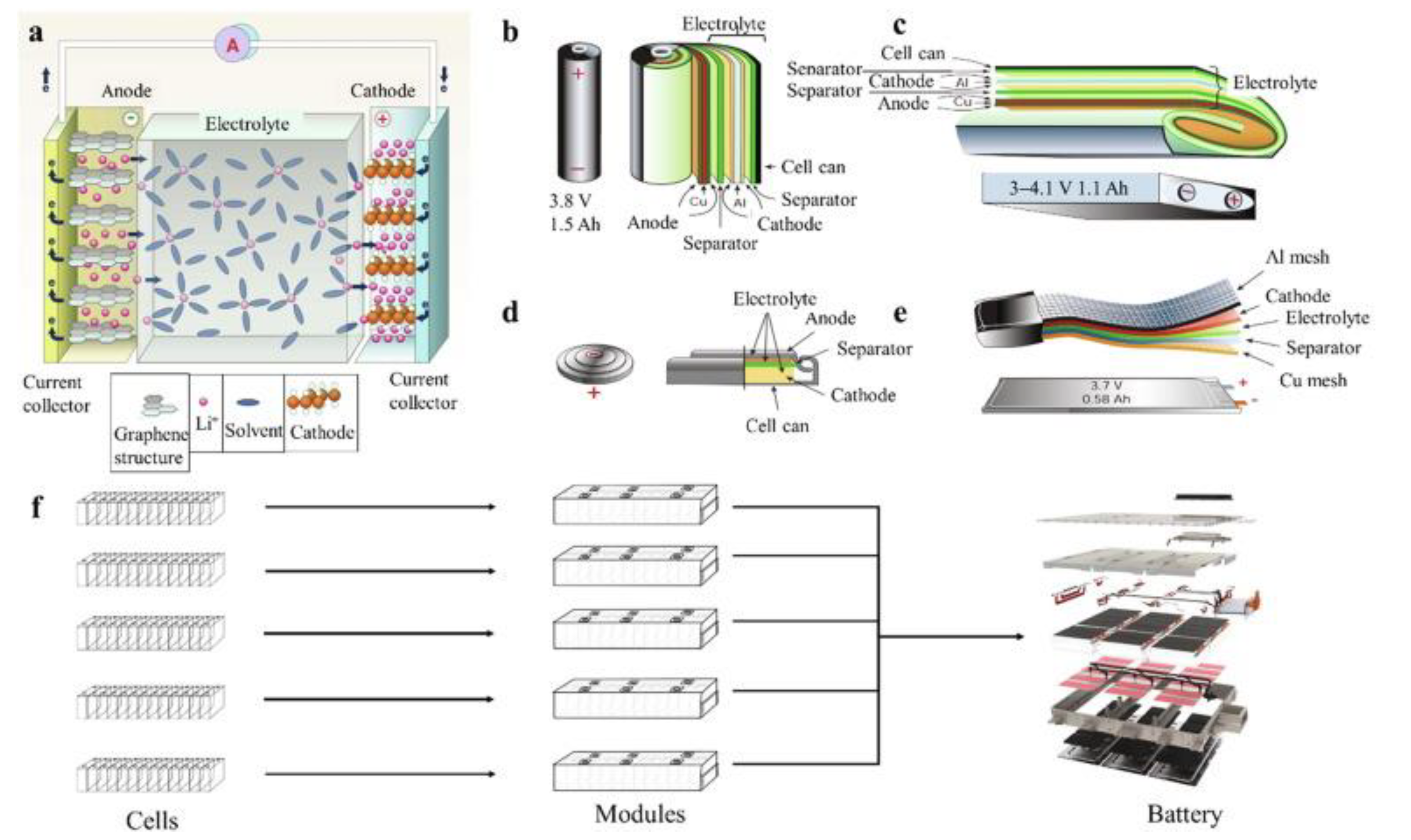
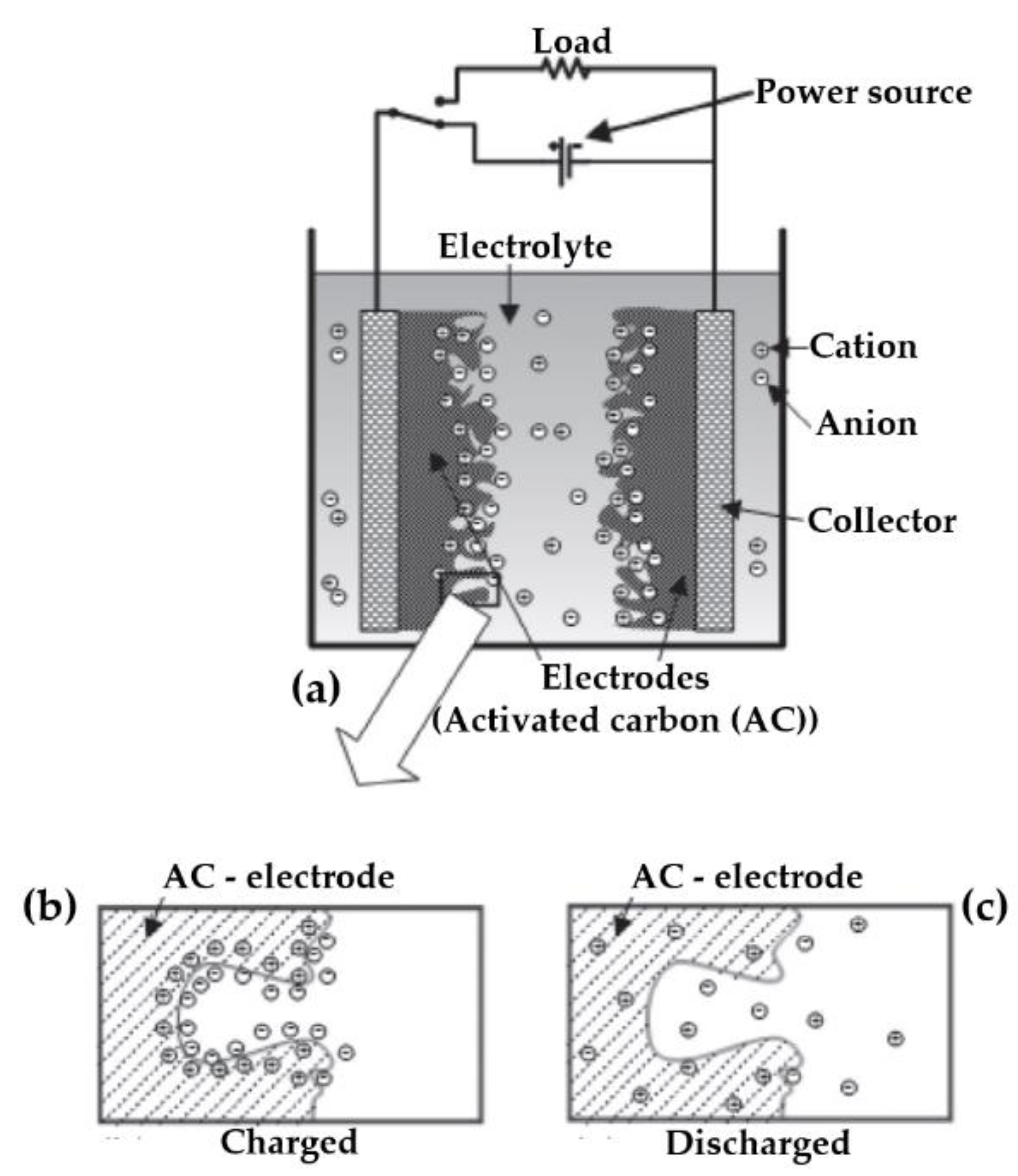
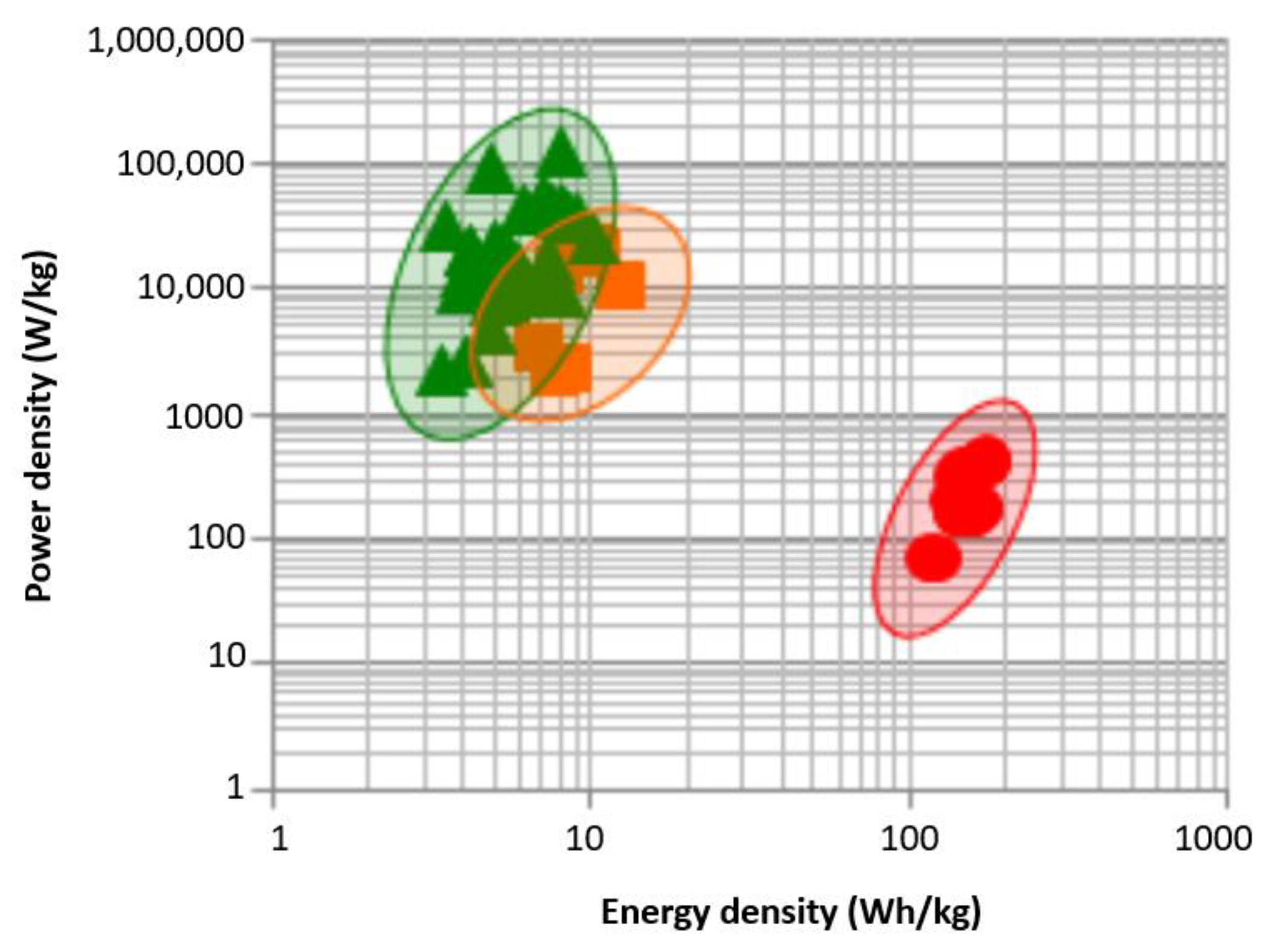
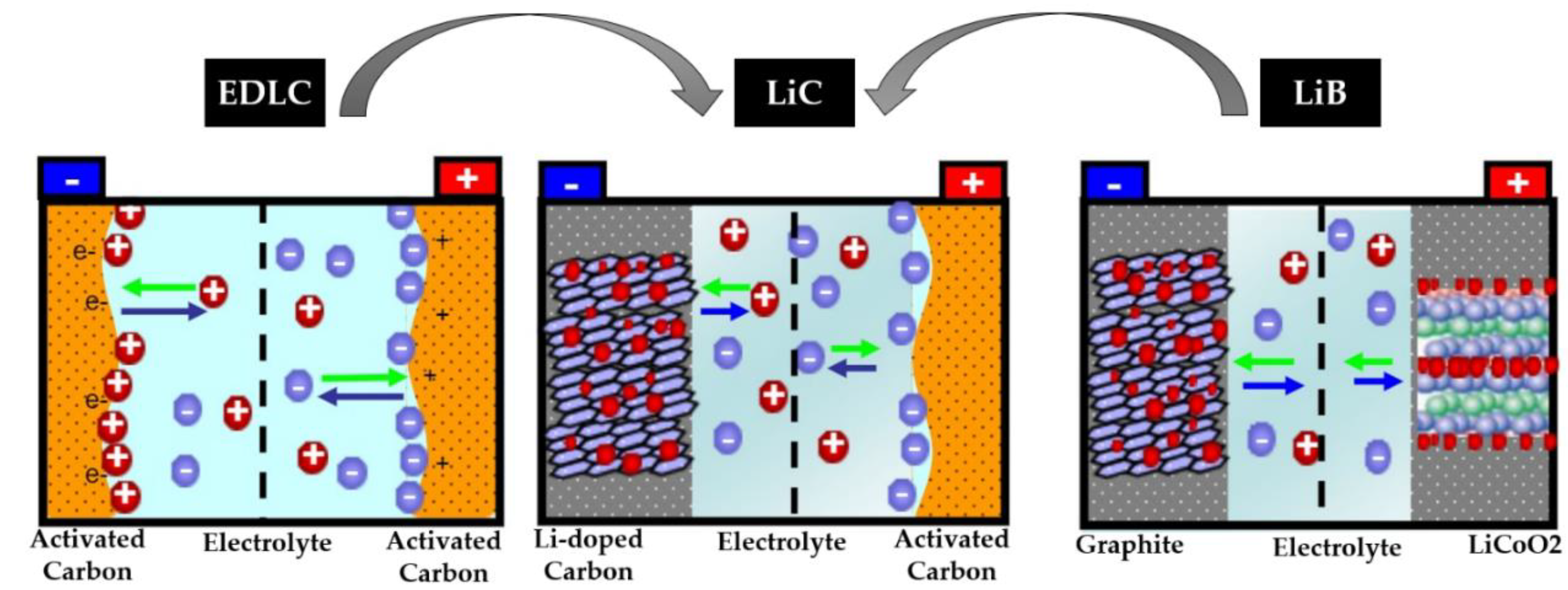
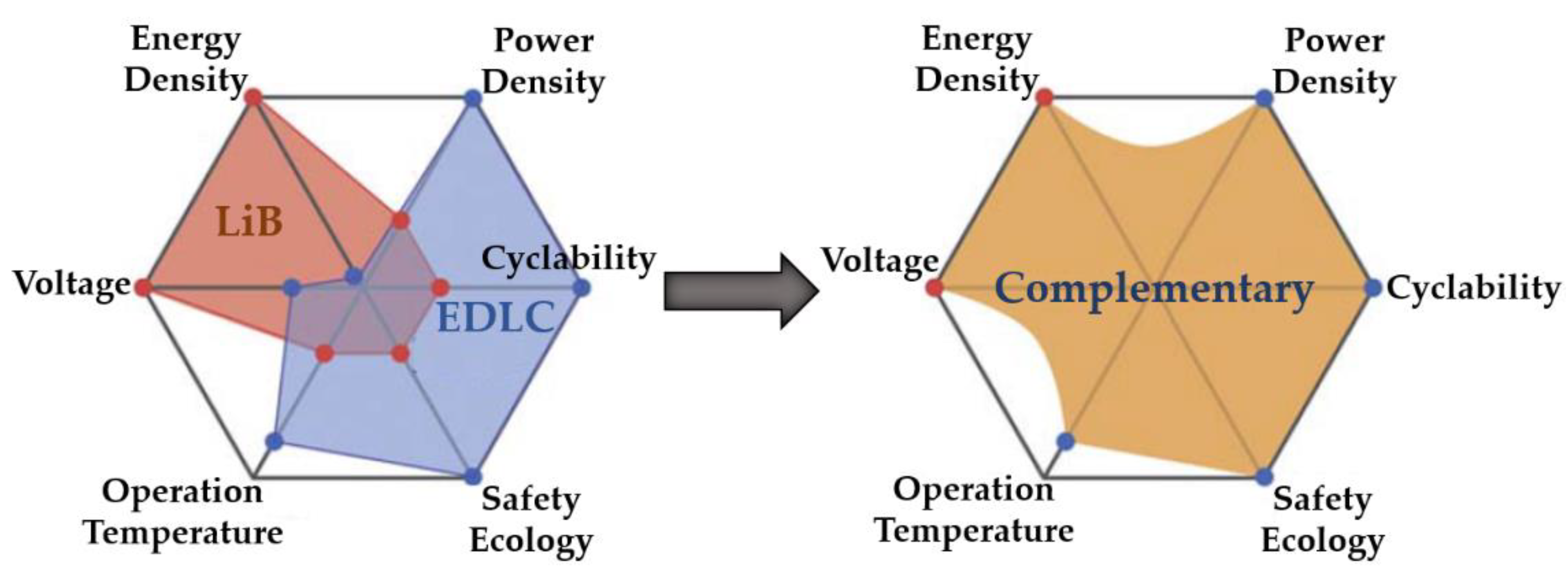
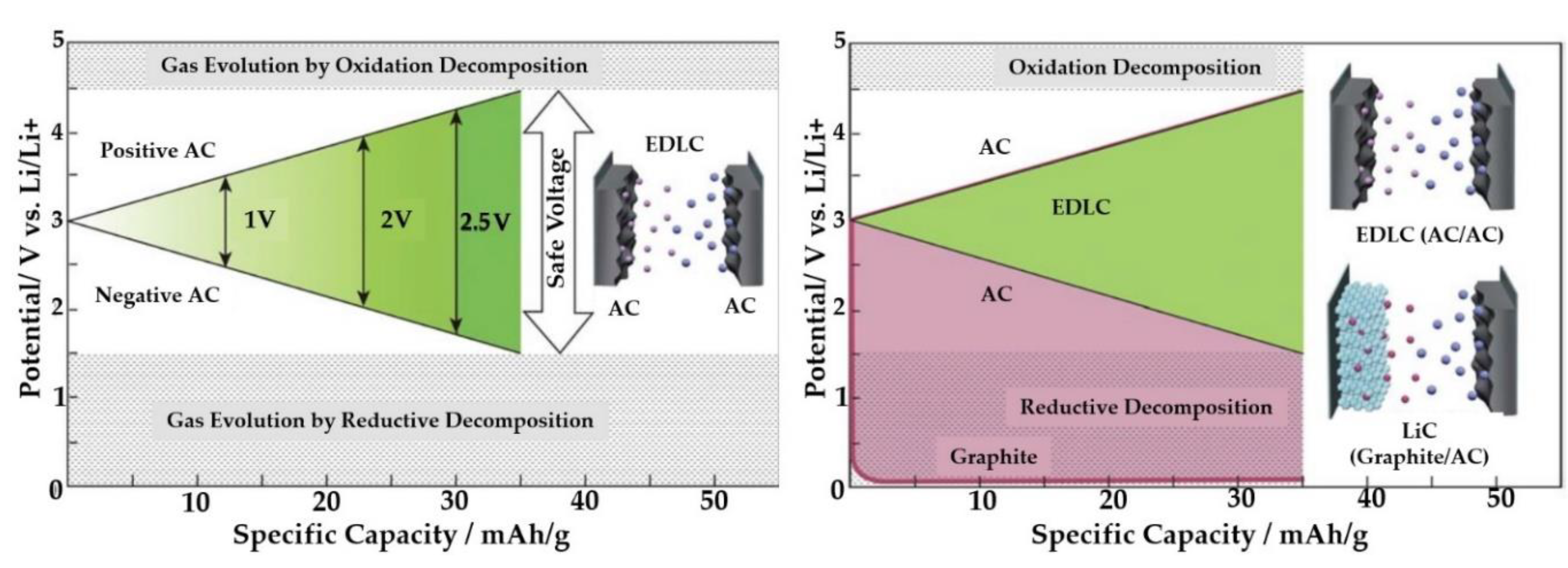
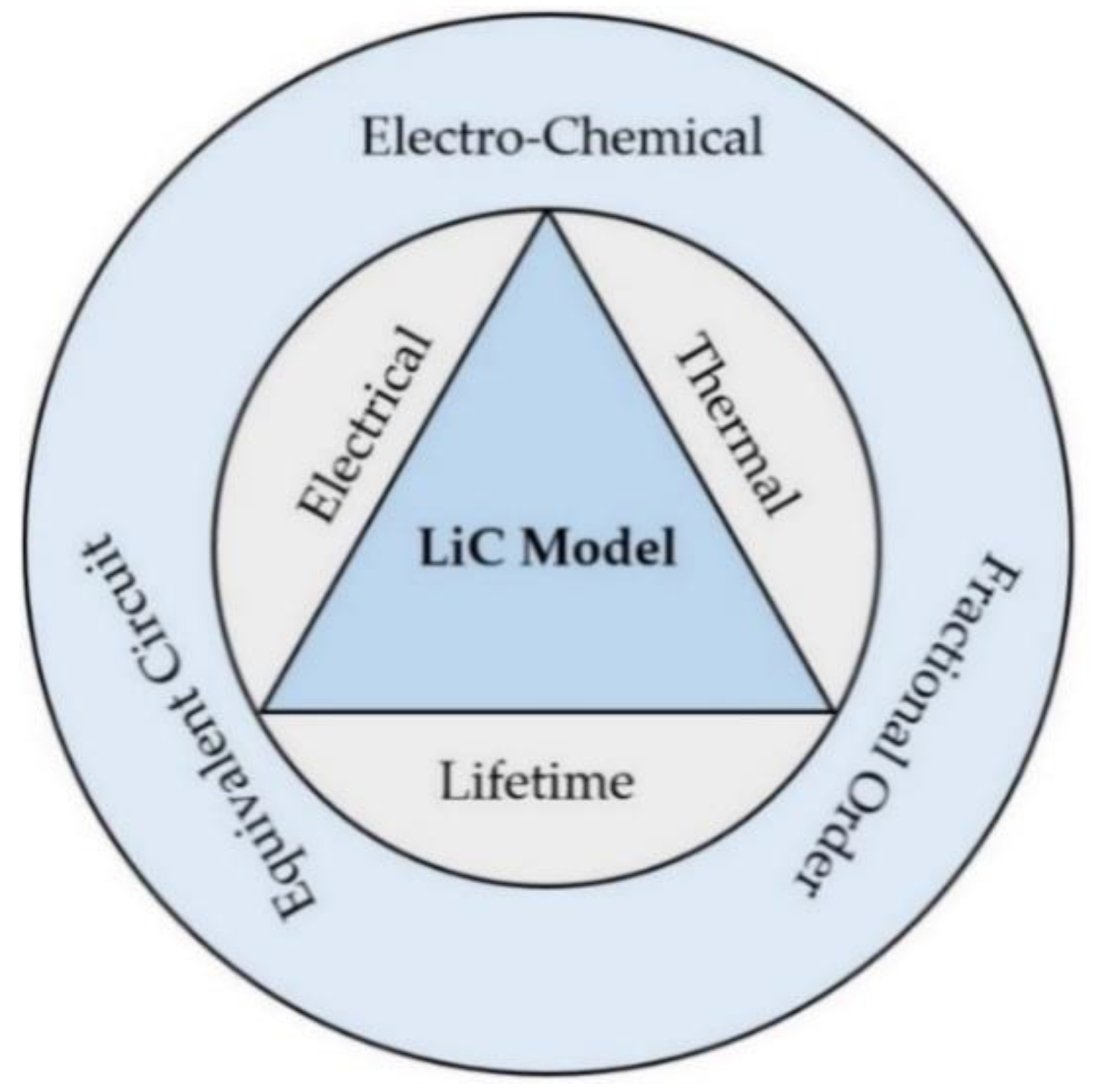
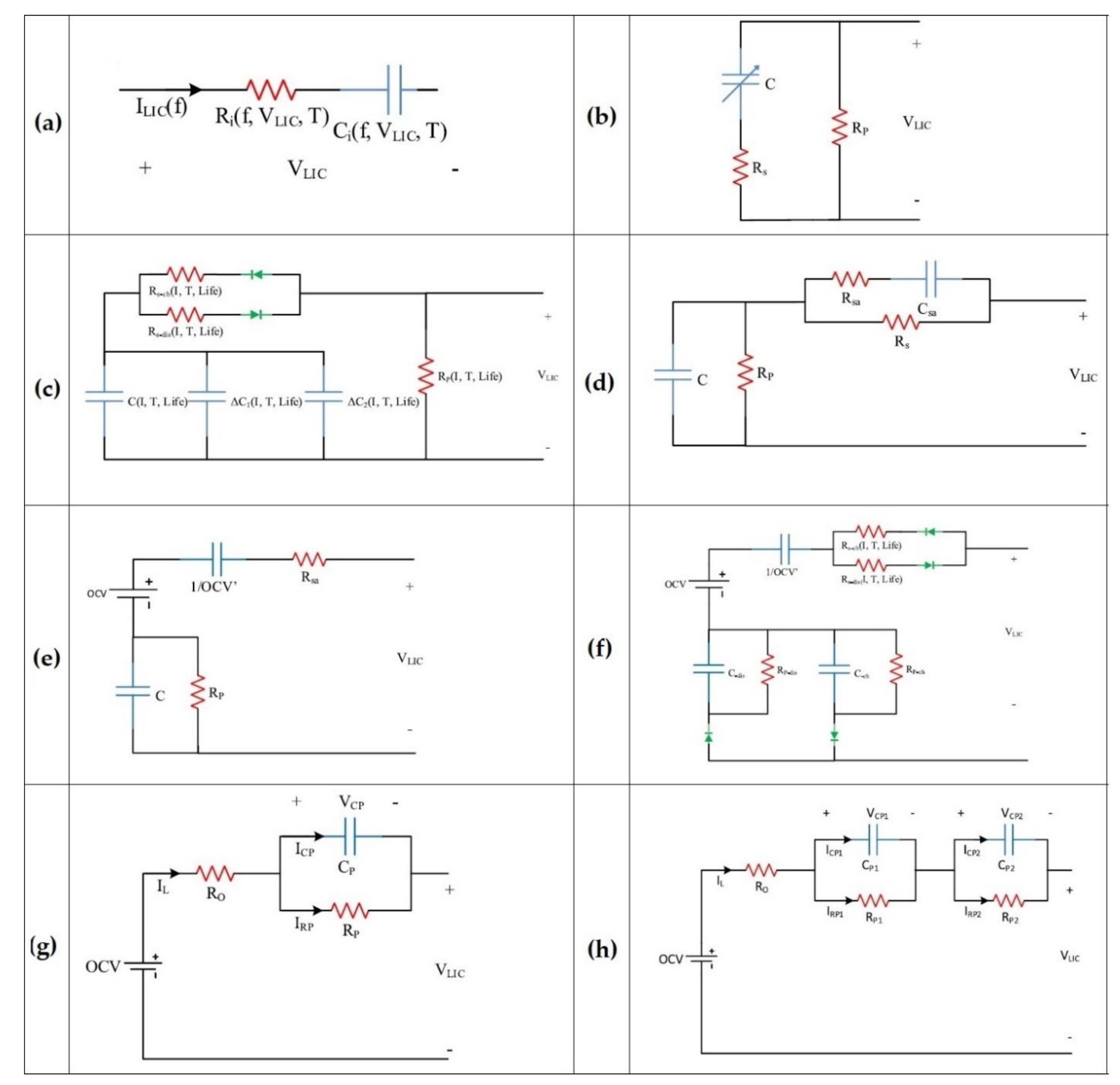
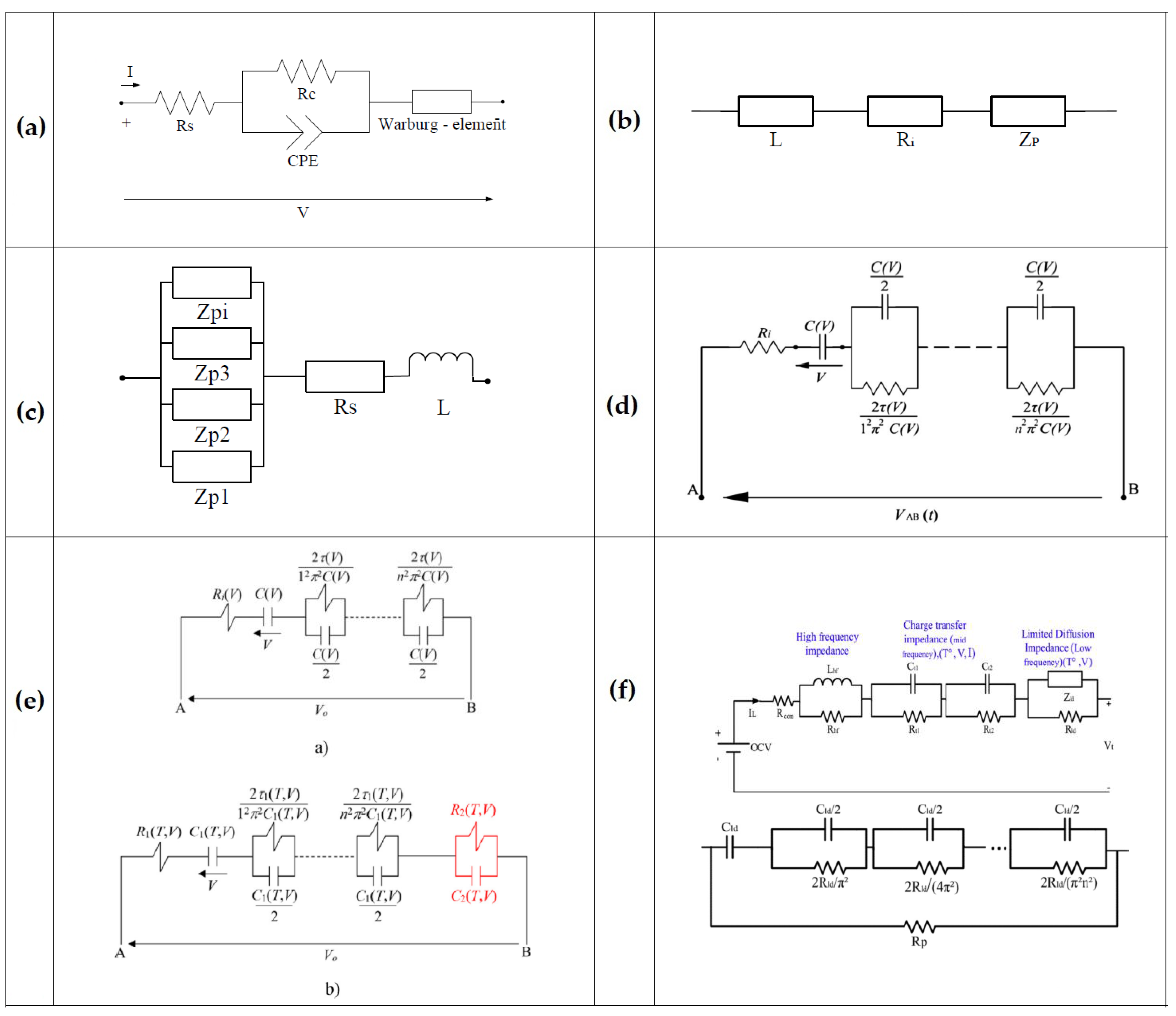
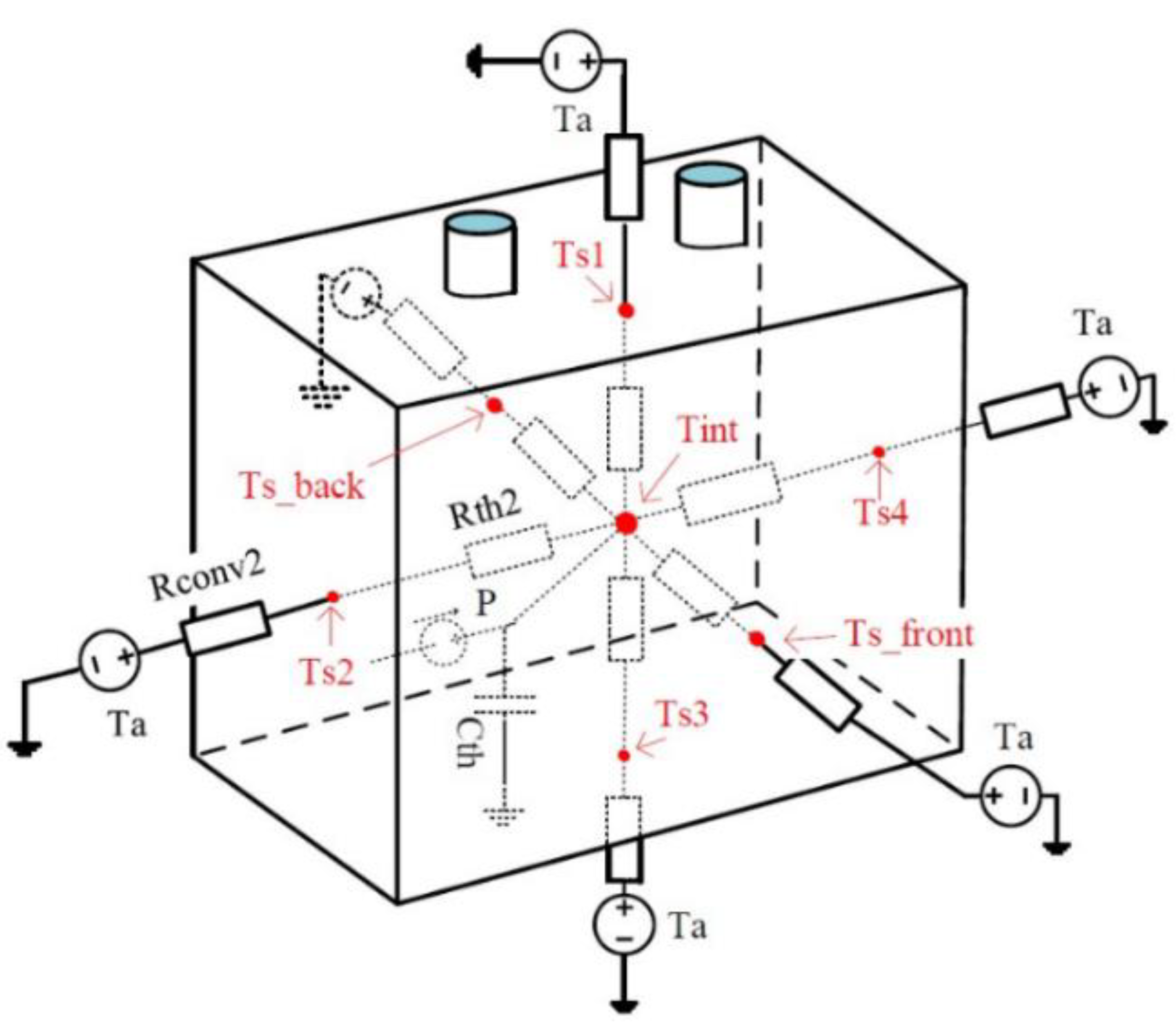
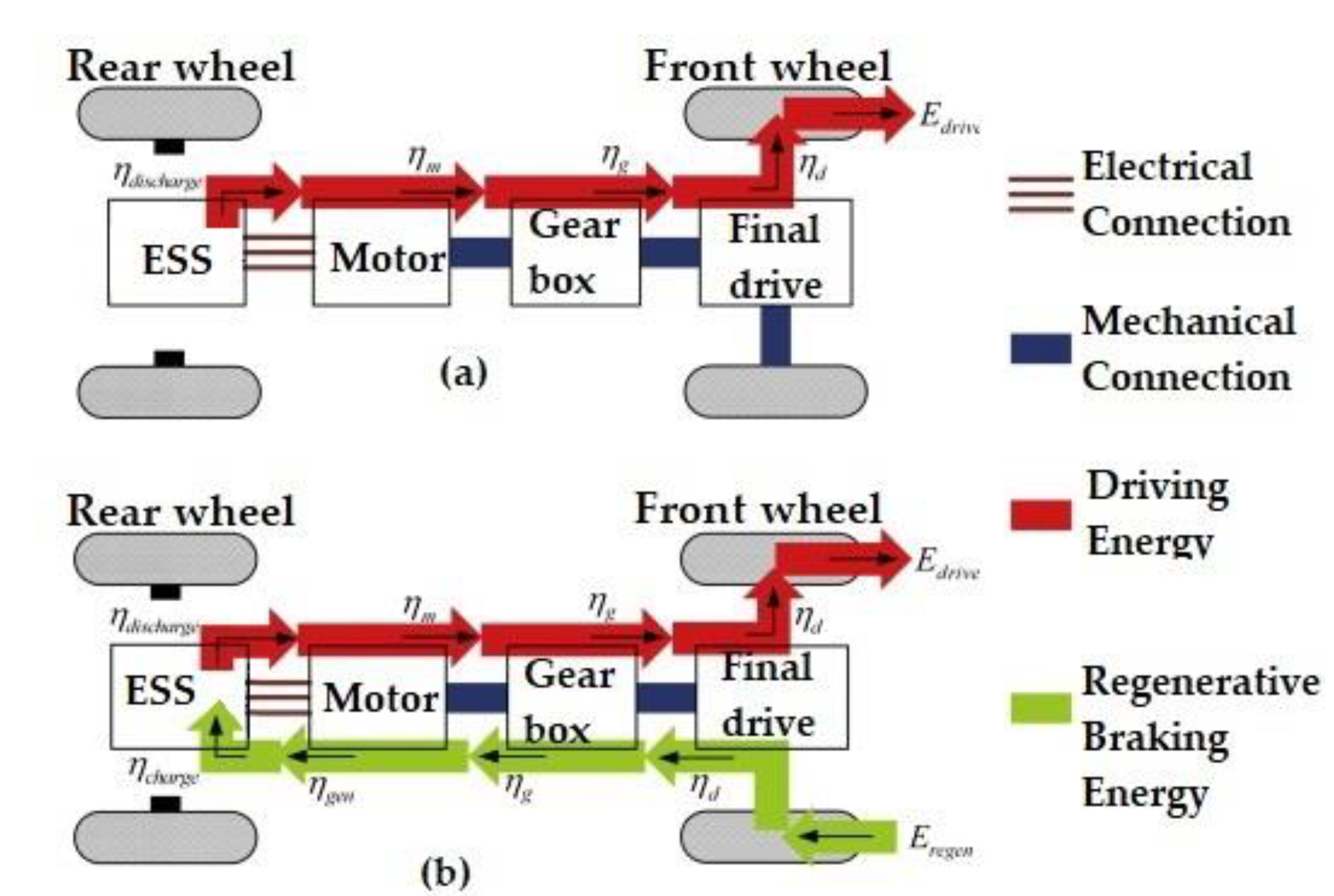
| Ref. | Application | Cell/Module | Active | Passive | Hybrid |
|---|---|---|---|---|---|
| [123] | Thermal behavior analysis | Cell | - | ✓ | - |
| [126] | Cooling system design | Cell | - | ✓ | - |
| [124] | Cooling system design | Module | ✓ | - | - |
| [127] | Cooling system design | Cell & Module | - | ✓ | - |
| [128] | Cooling system design | Cell | ✓ | - | - |
| [129] | Uniformity analysis | Cell | - | ✓ | - |
| [130] | Cooling system design | Cell | ✓ | - | - |
| [131] | Cooling system design, uniformity analysis | Cell | ✓ | ✓ | ✓ |
| [42] | Lifetime analysis | Cell | ✓ | ✓ | - |
| [132] | Cooling system design, uniformity analysis | Cell | - | ✓ | ✓ |
| [133] | Holistic 1D/3D model, cooling system design | Cell | - | ✓ | ✓ |
| [134] | Cooling system design, uniformity analysis | Cell & Module | ✓ | - | - |
| [135] | Cooling system design, uniformity analysis | Cell & Module | ✓ | - | - |
| [136] | Cooling system design, uniformity analysis | Cell & Module | ✓ | ✓ | ✓ |
| [137] | Cooling system design | Cell | ✓ | - | - |
| Ref. | Heat Generation Mechanism | Heat Generation Assumption | Advantage | Disadvantage |
|---|---|---|---|---|
| [34] | Irreversible heat | Uniform | Low computational effort, easy parameters extraction | Low Precision |
| [59] | Irreversible heat | Uniform | Low computational effort, easy parameters extraction | Low Precision |
| [121] | Irreversible heat | Uniform | Low computational effort, easy parameters extraction | Low Precision |
| [140] | Reversible heat | Non-uniform | High precision, heat distribution description good | Heavy computational effort, harder parameter extraction |
| [121] | Reversible heat | Uniform | Low computational effort, easy parameters extraction | Low Precision |
| [140] | Reversible heat | Non-uniform | High precision, heat distribution description good | Heavy computational effort, harder parameter extraction |
Publisher’s Note: MDPI stays neutral with regard to jurisdictional claims in published maps and institutional affiliations. |
© 2022 by the authors. Licensee MDPI, Basel, Switzerland. This article is an open access article distributed under the terms and conditions of the Creative Commons Attribution (CC BY) license (https://creativecommons.org/licenses/by/4.0/).
Share and Cite
Karimi, D.; Behi, H.; Van Mierlo, J.; Berecibar, M. A Comprehensive Review of Lithium-Ion Capacitor Technology: Theory, Development, Modeling, Thermal Management Systems, and Applications. Molecules 2022, 27, 3119. https://doi.org/10.3390/molecules27103119
Karimi D, Behi H, Van Mierlo J, Berecibar M. A Comprehensive Review of Lithium-Ion Capacitor Technology: Theory, Development, Modeling, Thermal Management Systems, and Applications. Molecules. 2022; 27(10):3119. https://doi.org/10.3390/molecules27103119
Chicago/Turabian StyleKarimi, Danial, Hamidreza Behi, Joeri Van Mierlo, and Maitane Berecibar. 2022. "A Comprehensive Review of Lithium-Ion Capacitor Technology: Theory, Development, Modeling, Thermal Management Systems, and Applications" Molecules 27, no. 10: 3119. https://doi.org/10.3390/molecules27103119
APA StyleKarimi, D., Behi, H., Van Mierlo, J., & Berecibar, M. (2022). A Comprehensive Review of Lithium-Ion Capacitor Technology: Theory, Development, Modeling, Thermal Management Systems, and Applications. Molecules, 27(10), 3119. https://doi.org/10.3390/molecules27103119









